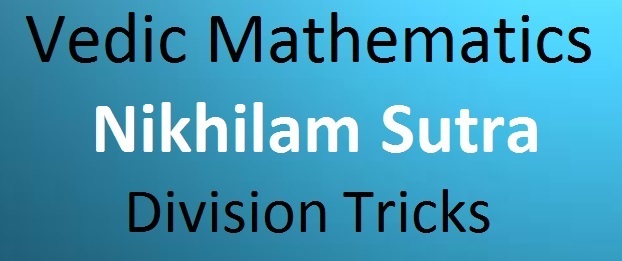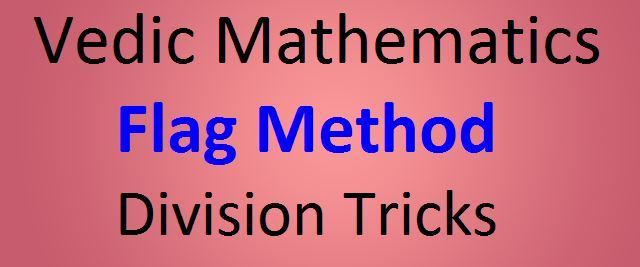Reciprocals can be classified as
- Non-Recurring Decimals
- Recurring Decimals
Non-Recurring Decimals:
1/2 = 0.5
1/5 = 0.2
1/10 = 0.1
When the Divisors are 2, 5 and 10 the number of non recurring digits after decimal is 1.
Likewise, each 2, 5 and 10 contribute 1 non recurring digit
1/4 = 1/(2*2) = 0.25
1/25 = 1/(5*5) = 0.04
1/40 = 1/(2*2*10) = 0.025 (Don’t factorize 10 as 2*5)
1/160 = 1/(2*2*2*2*10) = 0.00625
Observation:
When we multiply last digit of divisor by the last digit of actual answer then we always get a number having last digit as 0. So knowing the divisor we can easily confirm the last digit of answer (We cannot predict last digit of answer only when divisor has 0 as last digit).
Recurring Decimals:
1/3 = 0. 3(recurring digit)
1/7 = 0.142857 (with Circulating digits from 1 to 7)
1/11=0.09 (Circulating digits)
1/9= 0.1 (recurring digit)
Observation:
When we multiply last digit of divisor by the last digit of actual answer then we always get a number having last digit as 9. So knowing the divisor we can easily confirm the last digit of answer.
Examples:
Lets see how to calculate 1/7
When we carry out 1/7 using usual method of division, we get successive remainders as 3, 2, 6, 4, 5 and 1 and same sequence is followed repeatedly. Last obtained 1 is same as the numerator.
Dividends used initially are 10 and 30. Same ratio is also observed for the remainders. We need to concentrate on the remainders.
The Ratio is 1:3 and the remainders are going to follow same ratio or better to say they will remain in Geometric Progression (G.P.)
- Thus intial remainders are 1 and 3.
- By G.P. after 3, 9 will come. But as we are talking about remainders (for 7) remainder cannot be > 6 so we need to subtract the 7’s. So 9-7= 2.
- By G.P. after 2 comes 6.
- By G.P. after 6 comes 18, so again subtract 7’s (need to subtract 14) which gives 4.
- By G.P. after 4 comes 12, subtract 7’s from 12 which gives 5.
- By G.P. after 5 comes 15, subtracting 7’s from 15 gives 1 (which we had earlier, so stop to the previous step as digits are going to repeat).
So by this shortcut method successive remainders obtained are 1, 3, 2, 6, 4 and 5.
Now multiply each remainder by 10 (10, 30, 20, 60, 40 and 50), divide by 7 and simple take their quotient: 1, 4, 2, 8, 5 and 7.
Final answer = 0.142857 (with Circulating digits from 1 to 7)
Observation:
If we divide remainders in 2 equal halves (132/645), lined them vertically and on column wise additions each gives 7 (our same divisor).
Also if we do same for Quotients, each columnwise addition gives 9.
Lets see how to calculate 1/13
- As above process, Initial Remainders are 1 and 10. So ratio is going to be 1:10 in G.P. for remainders.
- By G.P. after 10 comes 100, subtracting 13’s (91) gives 9
- By G.P. after 9 comes 90, subtracting 13’s (78) gives 12
- By G.P. after 12 comes 120, subtracting 13’s (117) gives 3
- By G.P. after 3 comes 30, subtracting 13’s (26) gives 4
- By G.P. after 4 comes 40, subtracting 13’s (39) gives 1 which was obtained earlier so stop to previous step.
So the remainders are 1, 10, 9, 12, 3 and 4.
Now multiply each remainder by 10 (10, 100, 90, 120, 30 and 40), divide by 13 and simple take their quotient: 0, 7, 6, 9, 2 and 3.
Final answer = 0.076923 (with Circulating digits from 0 to 3)
Observation:
Again if we divide remainders in 2 equal halves, lined them vertically and on column wise additions each gives 13 (our same divisor).
Also if we do same for Quotients, each columnwise addition gives 9.
another method for such reciprocals.
Sesani Ankena Caramena
Sanskrit Name:
शेषाण्यड्केन चरमेण
English Translation:
The remainders by last digit (Sesa: Remainder, Caramena: Last Digit).
Example: 1/7
- As seen earlier successive remainders are 1, 3, 2, 6, 4 and 5.
- We will write them as 3, 2, 6, 4, 5 and 1.
- Multiply them with last digit of divisor (7): 21, 14, 42, 28, 35 and 7
- Now take their last digits and that’s the final answer: 0.142857. (another interesting concept).
Example: 1/13
- Successive remainders are 1, 10, 9, 12, 3 and 4.
- We will write them as 10, 9, 12, 3, 4 and 1.
- Multiply with last digit of divisor (3): 30, 27, 36, 9, 12 and 3.
- Taking just last digits gives final answer: 0.076923.
Example: 1/17
- Successive remainders are 10, 15, 14, 4, 6, 9, 5, 16, 7, 2, 3, 13, 11, 8, 12 and 1.
- Carry out same procedure and check the final answer with calculator.
(Obtaining remainders for 1/17 is very lengthy process so very advisable to make divisor end with 9 and apply the method seen on previous page.)



Leave a Reply
You must be logged in to post a comment.